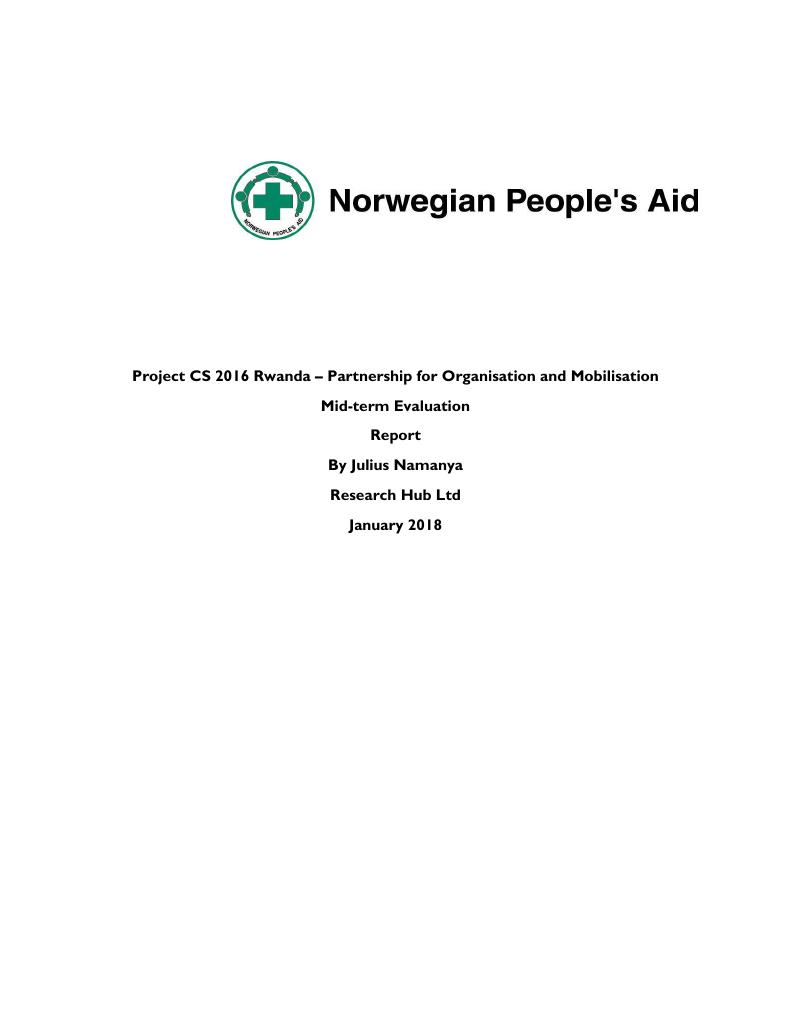Evaluering
Project CS 2016 Rwanda – Partnership for Organisation and Mobilisation Mid-term Evaluation
Background Research Hub was contracted to do a mid-term review of the partnership and mobilisation project that commenced in 2016 and is due to end in 2019. The project funded by Norad, is being implemented by Norwegian people’s aid (NPA) in seventeen countries. In Rwanda, the project is implemented in nine districts by Pro-femmes Twese hamwe, AJPRODHO, Tubibe Amahoro, RWAMREC, COPORWA and Rwanda women network (RWN). Through mobilising partners around common issues, and helping civil society to achieve effectiveness in organising people who have a common cause, the project hopes tocontribute the long term goal of strengthening democratic process in Rwanda. Purpose/objective The overarching objective of midterm evaluation was to inform programme planning in the remaining yearsof the project. By pausing, reflecting and learning from what has been achieved NPA hopes to look aheadwith a fresh perspective, hence the need for an external consultant to guide the process. The study sought toanswer six key evaluation questions; To what extent are project objectives clear to NPA staff and partners? To what extent do partners and supported projects match programme objectives? To what degree is programme learning integral to decision making? Are there opportunities to reflect, learn and improve across NPA and partners and within partners themselves? What is the level of enthusiasm and dynamism between NPA and her partners How relevant is the project given the Rwandan context What impact has the project mid-way through? Methodology Desk review- a host of documents from NPA results framework to partner proposals were reviewed to get an idea of what it is the project aims to achieve and explore synergy and complementarity across. Indepth interview with partners and NPA staff. The aim for in-depth interviews was to explore their perceptions of GBV and prevention measures, reporting channel, advocacy plan, research agenda, project achievements, best practices and success stories and the challenges they encountered so far. Focus group discussions were organized to understand participants’ perceptions of Gender Based Violence, GBV prevention measures and how it affects men and women, the level of knowledge in Gender issues, best practices, successful stories and innovations and the effect of the knowledge acquired during the training. Key findings Partners understand the project but some of them pointed out that they did not know enough about the work of other partners. The project is relevant to the Rwandan context but NPA and her partners need to strategically think about how best to tackle broader democratic governance within the limited space available. The project is filling the coordination void at the decentralised levels. Achieving advocacy goals at lower levels is hampered by Government of Rwanda’s top down governance approach and lacking advocacy stratagem on the part of partners. Documentation of learnings from parents evening forum (PEF) Monitoring advocacy group (MAG) community scorecard weak and a lot more needed. Partners have built strong rapport with government institutions and that this relationship could be leveraged to push through their agenda. Recommendations Consider training partners in rights based approach Build partner capacity in advocacy tactics suitable to the Rwandan context. Strengthen advocacy efforts at national level in collaboration with other civil society organisations/international non-governmental organisations given Rwanda’s top down governance system, influencing decentralised entities may not yield fruit. Develop practical advocacy tools to support the identification of issues, packaging of information developing position papers, fact sheets. This should be considered by partners as well as NPA during the development of advocacy plans of partners. Analyse the effect of interventions on both men and women and adopt gender sensitive monitoring and evaluation by adopting tools that generate gender disaggregated. Indicators in the partner and NPA matrix should always show progress and or impact of activities on both men and women. For example having an indicator on GBV prevalence should not be enough. It should show prevalence among men and women. Aggregate all learnings from PEF, MAG and create lessons learned document ahead of the final evaluation in 2019. Learnings could also be shared with other stakeholders Integrate MAG and community score card into district planning process and ensure that the feedback from these forums is fed into the performance work plans of sectors and districts. Integrate policy analysis, research into the advocacy plans of partners. Routine data collected by partners might raise issues that require further investigation. Hence partners ought to be in a position to internally interrogate this data by investigating further. This might require equipping partners with skills to internally analyse government policies and programmes such as vision Umurenge programme, Girinka etc. Explore possibility of transferring cross-learning responsibility to one partner or get on-board neutral entity. This entity would on an ongoing basis, document best practises, and case studies and disseminate what is known to work to all partners. Use the expiry of the gender based violence strategic plan as an opportunity to influence the next one Comments from the organisation In the MTR the researchers address the quality of the work of the partners, but leaves out the assessmentconcerning the relevance of the partners and their work to the programme. Though the researchers had questions regarding relevance, they considered it was not within their remit to include these perspectives in the report, nonetheless this perspective was not specifically mentioned in the ToR of the MTR.
